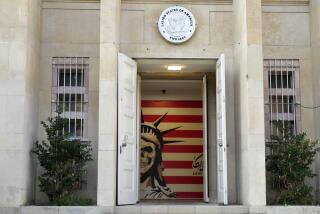Iran’s Former Leader Traces Dialogue to ’84
- Share via
PARIS — The former president of Iran, Abolhassan Bani-Sadr, says that Tehran made the first move toward a rapprochement with the United States in 1984, and that the two countries later agreed that Iraqi President Saddam Hussein should be ousted.
In an interview with the Associated Press, Bani-Sadr said the Iranians made many contacts in three European “centers” that were established to engender better relations. He said this was “certainly” done with the accord of Iranian leader Ayatollah Ruhollah Khomeini.
Bani-Sadr, first president of Iran’s revolutionary Islamic Republic, said his information was based mainly on contacts inside Iran. An aide said that Bani-Sadr, who fled his country in 1981, still has contacts within the Iranian government, the army and other vital sectors. His information could not be independently confirmed.
Bani-Sadr repeated his claim that Robert C. McFarlane, former national security adviser to President Reagan, made two trips to Iran, at the end of May or in June, and again in September.
McFarlane Role Stressed
McFarlane played an important part in the secret shipment of U.S. arms to Iran, but U.S. officials have acknowledged only one McFarlane trip, in May.
Bani-Sadr said that Iran, locked in a six-year-old war with Iraq, has been receiving U.S. arms and spare parts since 1981, via Israel and an international network that he called “a real multinational.”
Bani-Sadr attached special significance to a 23-ton shipment of spare parts that he said went along with McFarlane in September. It contained parts unavailable through the usual channels and symbolized a new phase in U.S.-Iranian relations, he said.
“It signified a political arrangement for the Iran-Iraq war,” he said.
Bani-Sadr said that dealings between Iran and the United States were based on an agreement, reached early in 1985, that the Iraqi president would be driven from power.
This accord, he said, paved the way to McFarlane’s two visits to Tehran and an “air bridge” for regular delivery of armaments.
Strategy of Ouster
Bani-Sadr said he did not know whether Iran and the United States were planning to work together to oust Hussein.
He added that the United States “wanted to retain the (state) apparatus, but make Saddam leave in a way that would satisfy the Rafsanjani faction in Iran.”
Analysts have identified Hashemi Rafsanjani, Iran’s powerful parliamentary speaker, as a leader of “pragmatists” who are seeking a way to end the war. An arrangement for Hussein’s ouster would allow Rafsanjani to claim victory for Iran but would protect Iraq from the upheaval of an Iranian-style revolution, Bani-Sadr said.
More to Read
Sign up for Essential California
The most important California stories and recommendations in your inbox every morning.
You may occasionally receive promotional content from the Los Angeles Times.












